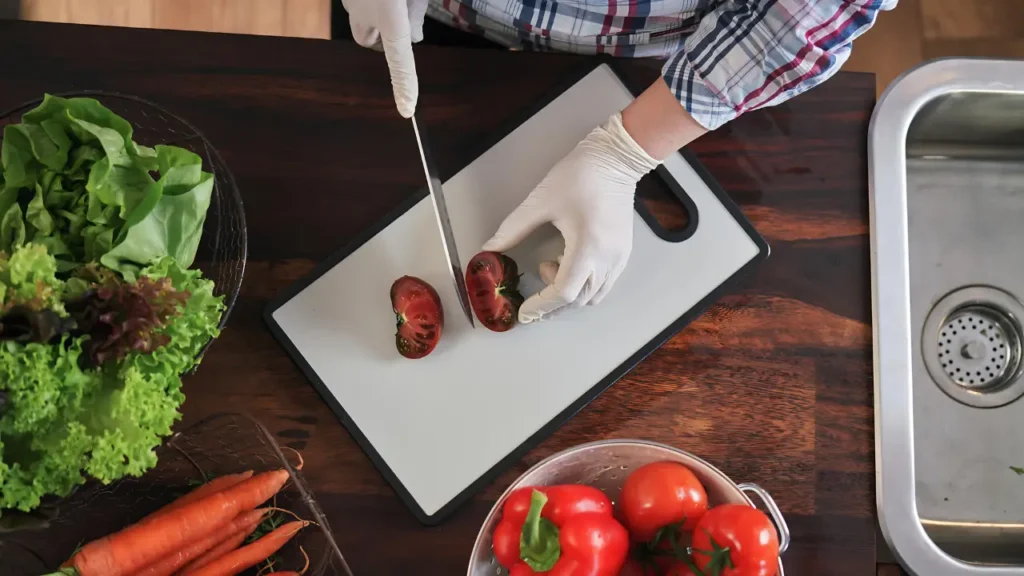Selecting the right gloves for food handling is crucial in maintaining high standards of hygiene and safety in any food service setting. The primary concern is always to prevent food contamination and ensure that all food prepared is safe for consumption. Different types of gloves provide varying levels of protection and are suitable for various tasks within the food industry. With regulations and health guidelines becoming stricter, understanding which gloves are food safe is essential for all food service professionals. This article will guide you through the different types of gloves suitable for food handling, the regulations that govern their use, and best practices for ensuring maximum food safety.
Table of Contents
Understanding Food Safety Standards for Gloves
Food safety is paramount, and the standards set for food-handling gloves are designed to protect consumers. Food safety gloves regulations dictate which materials and designs are suitable for direct contact with food. In the United States, the FDA regulates glove materials such as nitrile, latex, polyethylene, and vinyl to ensure they are safe for food contact.
These materials need to meet specific criteria for food safety, such as resistance to punctures and chemicals, as well as not transferring harmful substances to food. Knowing these regulations helps food service professionals make informed decisions about food-grade glove requirements and maintain compliance with health standards.

Types of Food Safe Gloves
When considering which gloves are food safe, it is essential to understand the different materials available. Nitrile gloves are popular for food handling due to their resistance to oils, fats, and chemicals, making them suitable for processing meat and oily foods. Latex gloves offer superior dexterity and comfort, which is perfect for preparing ready-to-eat foods;
however, they pose allergy risks for some individuals, prompting a shift towards allergy-safe gloves for food prep. Vinyl gloves are a cost-effective option for tasks that require frequent glove changes, such as serving or light food preparation. Finally, polyethylene gloves are best for short-duration tasks where frequent glove changes are required.
Selecting the Right Gloves for Different Kitchen Tasks
which gloves are food safe gloves for kitchen staff involves considering the specific needs of each task. For handling raw meat and seafood, durable nitrile gloves are preferred due to their puncture resistance and ability to prevent cross-contamination.
When preparing salads or sandwiches, it’s essential to use gloves that prevent any transfer of allergens and bacteria, making latex or nitrile gloves ideal, provided there are no allergy concerns. For cleaning and other sanitizing tasks, gloves that can withstand harsh chemicals, like thicker nitrile gloves, are necessary to protect the hands and ensure thorough sanitation.
Best Practices for Glove Use in Kitchens
Effective glove use is a critical component of food safety in any culinary setting. Disposable gloves in food service should be changed frequently to prevent cross-contamination between different food types and kitchen tasks. It is essential to train staff on how to properly put on and remove gloves to avoid touching the outside of the glove.
Additionally, which gloves are food safe, it’s important to ensure hands are washed thoroughly before putting on a new pair of gloves. These practices help maintain a hygienic environment and are a staple in glove use in restaurant kitchens, ensuring that every meal served is not only delicious but also safe.
Common Misconceptions About Gloves in Food Safety
There are several myths surrounding the use of which gloves are food safe, one of the most common being that gloves eliminate the risk of contamination. This misconception can lead to complacency among kitchen staff, undermining the effectiveness of other hygiene practices. It’s important to recognize that gloves can still harbor bacteria if not changed regularly or if used improperly.
Another myth is that all glove types offer the same level of protection. In reality, the suitability of vinyl gloves in the food industry, for instance, differs significantly from that of nitrile gloves, especially when handling fatty foods or during extensive food preparation tasks. Educating staff about these nuances and the actual benefits of different types of gloves is crucial in dispelling these myths and enhancing overall food safety.
Impact of Proper Glove Usage on Food Hygiene
Proper glove usage significantly impacts food hygiene and safety. It not only helps in preventing direct contact with food, thereby reducing the risk of contamination and spread of foodborne pathogens but also instills a discipline of cleanliness among the kitchen staff. Training on when and how to change gloves, such as between handling raw and cooked foods, is critical. Furthermore, integrating glove usage with other hygiene practices, such as regular handwashing and surface sanitizing, creates a comprehensive defense against contamination. This holistic approach to kitchen hygiene, centered around the best gloves for food handling, can significantly enhance the safety and quality of food served.
Economic Considerations in Choosing Food Safe Gloves
Choosing the right food safe gloves involves balancing cost with functionality. While nitrile gloves are generally more expensive than other types, their durability and chemical resistance can make them more cost-effective in the long run, especially in high-risk environments. On the other hand, vinyl gloves offer a more budget-friendly option for tasks requiring less durability and protection, making them suitable for food services with high glove turnover.
Economic considerations also extend to the environmental impact of disposable gloves. Options like reusable or biodegradable gloves, while initially more costly, can offer long-term savings by reducing waste and disposal costs. Understanding these economic factors is essential for making informed decisions about glove purchases that align with both budget constraints and safety requirements.
Technological Advancements in Food Safe Gloves
The development of new materials and technologies has significantly improved the quality and safety of gloves used in food handling. Innovations such as antimicrobial coatings and improved nitrile formulations enhance glove safety by providing additional barriers against contamination. These advancements also include improvements in glove textures, which enhance grip and dexterity—crucial factors in preventing accidents and improving efficiency in food preparation. As technology continues to evolve, staying informed about the latest developments in eco-friendly food preparation gloves and other innovations can help food service professionals stay ahead in maintaining the highest standards of food safety.
Legal and Regulatory Aspects of Food Safe Gloves
Adhering to legal and regulatory requirements is essential for any food service business to operate effectively and avoid penalties. Different regions have specific guidelines and standards governing the use of food safe gloves. For instance, the FDA in the United States requires that food contact gloves be made from materials that are safe and suitable for their intended use.
Additionally, the increasing focus on public health has led to stricter regulations regarding glove quality and usage. Keeping up-to-date with these regulations and ensuring compliance is crucial for all foodservice operators. This adherence not only protects consumers but also builds trust and credibility in the food service industry.
Conclusion on which gloves are food safe
The question of which gloves are food safe is not just about meeting regulatory requirements—it’s about fostering a culture of safety and cleanliness in food handling. By choosing the right gloves for specific tasks and adhering to best practices, food service professionals can significantly reduce the risk of foodborne illnesses. With the variety of gloves available, each kitchen can find the type that best suits their needs, balancing cost, comfort, and compliance to achieve the highest standards of food safety.
Which gloves are food safe for people with latex allergies?
Which gloves are food safe for people with latex allergies? Nitrile gloves are the best alternative, offering durability and protection without the allergens present in latex gloves. They provide excellent resistance to punctures and chemicals, making them ideal for food handling.
Are there reusable options when considering which gloves are food safe?
There are reusable options when considering which gloves are food safe. Reusable gloves made from materials like silicone or heavy-duty rubber are ideal for tasks requiring frequent glove use. They are durable, washable, and designed to withstand repeated use while maintaining safety standards in food handling.
What certifications should I check to know which gloves are food safe?
To determine which gloves are food safe, check for FDA (Food and Drug Administration) approval. This certification ensures the gloves meet safety standards for food handling in terms of material safety and barrier effectiveness. Look for the FDA mark on the packaging for assurance of compliance.
Can you explain which gloves are food safe for various cooking temperatures?
Different gloves are food safe for various cooking temperatures. Silicone gloves are best for high temperatures, offering heat resistance up to 500 degrees Fahrenheit, ideal for baking and grilling. For lower temperatures and general kitchen use, nitrile gloves provide adequate protection, and versatility, and are allergy-safe.
Which gloves are food safe and also environmentally friendly?
There are environmentally friendly gloves that are also food safe. Biodegradable nitrile gloves are a popular choice as they offer the necessary barrier protection for food handling while being eco-friendly. These gloves break down faster in landfills compared to traditional nitrile, reducing environmental impact.



